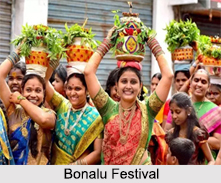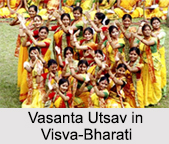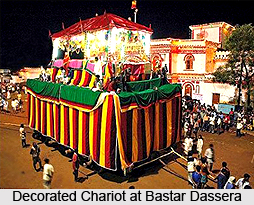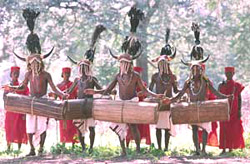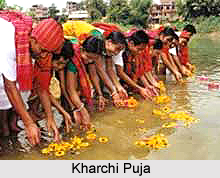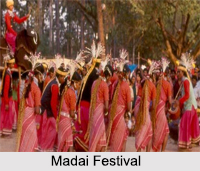 Nabapatrika was a popular ritual performed by the peasant folks for a flourishing harvest. Nabapatrika includes the worship of nine sacred plants.
Nabapatrika was a popular ritual performed by the peasant folks for a flourishing harvest. Nabapatrika includes the worship of nine sacred plants.
Nabapatrika is now an important part of the Durga Puja. During the autumn season peasants worshipped Goddess Nabapatrika in order to reap good harvest.
Later all the nine holy rituals of the Nabapatrika were performed during the ceremonies of Durga Puja. Nabapatrika represented the primitive form of Durga Puja which is still prevalent in some places.
Derivation of Nabapatrika
The word "Nava" means nine and "Patrika" means plant. This is installed in the pandal of Durga Puja.
Celebration of Nabapatrika
Nabapatrika is worshipped during Bodhon. The nine plants of Nabapatrika represent the nine forms of Goddess Durga. The nine plants are plantain, Kachvi, Turmeric, Jayanti, Wood apple, Pomegranate, Ashoka, Arum and Rice paddy. The Banana plant represents Goddess Brahmani, Kachvi represents Goddess Kalika, Jayanti denotes Kartiki, turmeric represents Goddess Durga, Wood apple denotes Lord Shiva, Pomegranate indicates Raktadantika, Asoka symbolises Sokharita, Arum represents Chamunda and rice paddy symbolises Goddess Lakshmi.
Installation of Nabapatrika
This is installed in the Durga Puja pandal on the Maha Saptami day. The nine plants are wrapped in a white or red sari which symbolically represents Goddess Durga. In a manner Nabapatrika also symbolizes the human life that is necessary for maintenance, well-being, and happiness. Each one of them is a separate expression of Lord Shiva.
Description of Nabapatrika
Goddess Brahmani is associated with plantain. Banana is an important item of all rituals. The plant is auspicious as it is used for the mangalghat in pujas. Kachu is an edible root. Goddess Kalika is the consort of Lord Shiva, the Goddess Kali. Turmeric is an edible root and one of the most important spices. It appears in all rituals, including life-cycle celebrations. It is the basic seasoning of any cooked food. It is considered as the plant of Goddess Durga herself. Goddess Kartiki is the Sakti of Kartik, Durga`s son. It is a tree as well as a name of Goddess Durga. The leaves of this tree are used to prevent and cure fevers. Bel is one of the sacred trees in West Bengal. It is vital for any Puja. Its leaves are usually offered to all deities, especially to Siva and his consorts. The pomegranate fruit is a regular item of offering in most pujas, especially Devi pujas. The tree is worshipped only during Durga Puja. The Ashoka is a sacred tree. Certain trees of these species are used as objects of worship. Ashoka is Lord Vishnu`s tree. Barren women may eat the leaves of this tree in the hope of becoming fertile. Goddess Chamunda who is associated with arum plant is the fearful aspect of the goddess that killed the demons Chanda and Munda.
Harvested Rice in Nabapatrika
The unhusked, harvested rice is the most sacred plant. It is the basis of life. Dhan is rice. The most common representation of the Lakshmi Devi is unhusked rice in a common measuring pot, the Lakkhipai.
Farewell of Nabapatrika
On the tenth day navapatrika`s farewell ritual is performed. Women offer milk products and sweets to the goddess in the Navapatrika form. During the Puja Navapatrika is placed to the right side of the image of Goddess Durga.
